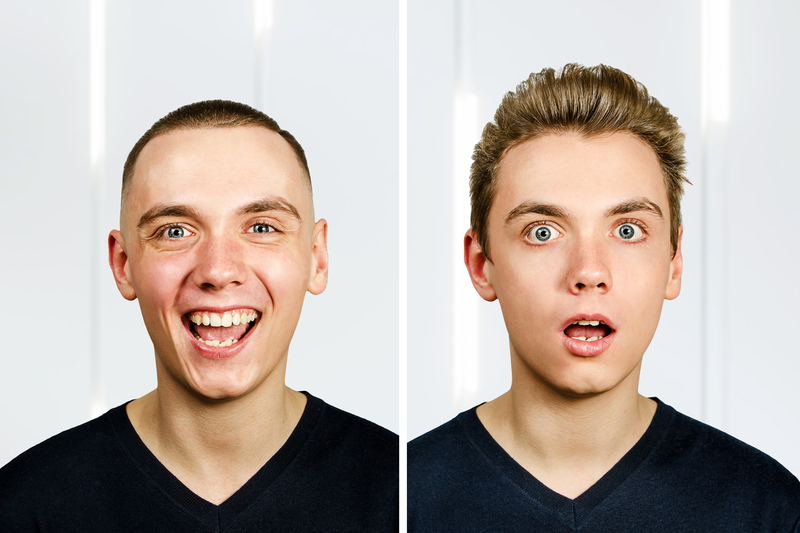5 Reasons Why You Should Avoid Hair Transplants and Alternative Procedures
Hair transplants, much like plastic surgery, require you to have a lot of things working in your favor:
The financial means to afford it, the right hair loss surgeon with years of experience, the support group to console you as you go through your transition… and of course, the mental willpower to look absolutely hideous until the entire process is done.
But you don’t have to go through the hellish nightmare of a hair transplant – we’ll show you a superior alternative at the end of this quick article.
However, if you’re thinking about a hair transplant and secretly wishing for someone to talk you out of it — this article was written specifically for you.
What Is A Hair Transplant, And How Does It Work?
First, let’s dive into the process of getting a hair transplant from start to finish.
Hair transplants are better understood as “hair follicle transplants”. You’re taking the hair follicles from an area of the head where hair grows normally (i.e. the “donor” site) and transferring them towards an area of the head that’s balding (i.e. the “recipient” site). In some cases a surgeon may even use hair follicles from other parts of your body.
This goal is achieved through two separate means, whichever one the surgeon feels will provide the best results:
“Follicular unit strip surgery (FUSS). The surgeon will remove a strip of skin from the donor area and close the incision with stitches. They will then use a microscope to separate the donor skin into tiny follicular units that contain one or several hair follicles and insert these units into the desired area.
Follicular unit extraction (FUE). The surgeon will use a tiny punch tool to remove follicles from the donor area. Although this procedure will still lead to some scarring, it may be less noticeable, and the person will not usually require stitches.”
Each of these procedures has their pros and cons, but nevertheless you will be subject to one or the other.
However, a look at the totality of the evidence surrounding hair transplants doesn’t show much promise in terms of efficacy.
In fact, a 2021 review comparing hair transplants to other treatments for androgenetic alopecia had the following to say:
“The rationale for hair transplantation in AGA is donor dominance, i.e., the transplanted hair continues to be unaffected by the balding process even after relocation to the new site”
“…there are a few absolute contraindications for the procedure such as an active autoimmune disease, uncontrolled diabetes/hypertension and patients allergic to local anesthetic, i.e., lignocaine. Patients younger than 25 years old tend to have unrealistic expectations and have progressive hair loss therefore they should be discouraged from undertaking hair transplants”
“Hair transplantation, while providing good cosmetic coverage for the bald areas, does not halt the progression of the disease. Hence, medications such as minoxidil and finasteride will need to be continued even after surgery.“
HINT: the study quoted barely touches upon the downsides!
5 Reasons Why You Should AVOID Hair Transplants
If this section doesn’t convince you why a hair transplant is arguably the worst option for treating thinning hair due to genetics and other lifestyle/environmental factors, nothing will.
Here’s a good idea of what you can expect to experience:
Reason #1: NASTY Side Effects
This scary infographic does a good job of summarizing the most common side effects of hair transplants:

Not to mention some of the more specific problems associated with each part of the transplant:
“FUT donor area complications: Bleeding, Folliculitis, Infection, Wound dehiscence or necrosis, Numbness, Persistent pain, Postoperative pain, Suture extrusion, Keloid and hypertrophic scar, Donor hair effluvium, Hiccups, Arteriovenous fistula
FUE donor area complications: Donor site depletion/moth-eaten appearance, Hypopigmentation/pinpoint scarring, Acute effluvium, Buried grafts, Higher transection rate, Keloid/hypertrophic scar, Epithelial cyst, Necrosis, Overharvesting, Numbness and persistent pain, Harvesting grafts outside safer zone
Recipient area complications: Poor hairline, Low density unnatural appearance, Recipient area edema, Necrosis, Postoperative folliculitis/pustules, Cysts”
Let’s keep going down the rabbit hole…
Reason #2: Unreasonably Expensive
Unless you’re swimming in money and absolutely desperate for a new head of hair, your cash is better spent elsewhere.
Some reasonable estimates for a hair transplant are:
- $4,000-$15,000 without any coverage from insurance, according to WebMD
- “$3 per graft,” so at 1,500-3,000 grafts that’s anywhere between $,500-$12,000 if you get your transplant done in Canada
- FUE transplants are around $9,000, while a FUT procedure starts around $7000 (Source: The Cole Clinic)
Keep in mind all of this is BEFORE any medications or additional costs you may have to take care of personally.
Still think it’s worth breaking your bank to get a hair transplant?
Reason #3: Takes Too Long To Produce Results
If we take the word of the Hair Transplant Institute, you’re looking at several months before results are visible:
“It will take a minimum of 3 months for follicles to shift into the anagen (growth) stage after transplantation.
Once wispy new hairs emerge around 3-4 months later, they’ll need another 4-5 months of slow growth to completely fill in the treatment area and create a lush result.
Most patients enjoy combing, styling and cutting their new locks around 9 months after hair surgery.”
That’s the long-term outlook, and your prospects of successful hair growth are even dimmer if you have a problem area or two:
“It takes at least 6–9 months for the full results of the hair transplant to be visible. In the case of larger areas of balding needing to be covered, it should be planned in multiple sittings with a gap of at least 4–6 months after the previous treatment”
On top of waiting a long time for results from the first transplant, and waiting even longer between additional transplants if you need them…
… the short-term waiting period isn’t much better: You’re looking at a 4-8 hour surgery with anywhere from 2-14 days of time off work to make a full recovery:
“It takes 2 weeks for newly implanted grafts to fully embed into the scalp following a hair transplant. This means that if you are worried about going to work and dislodging hairs, you will need to wait until 14 days have passed since your operation.”
Not looking good so far!
Reason #4: Your Hairline Looks “Fake”
In the video below you will see someone who has had a hair transplant done PROPERLY:
However, don’t assume you’ll look as handsome and flawless as the man in the video above.
One YouTube comment illustrates the point we want to make:
“Most of the people who notice hair transplants are people who have considered it themselves… I started looking into treatments for baldness 1 year ago and since then I’ve been noticing transplanted hairlines and FUT scars everywhere…”
Additionally, even if you spend your first few days post-surgery recovering with your head all wrapped up, experts note that there are many ways a hair transplant can look less than aesthetically pleasing:
“A bad hair transplant could result in a number of undesirable results, including obvious or excessive scarring, noticeable implant clusters, or unnatural hairlines.
An inexperienced hair surgeon might over-harvest the same area of the scalp during an FUE procedure, leaving suboptimal amounts of hair in the donor sites.
During FUT, an excision may be made in a visible location that creates a noticeable scar, even with surrounding hair growth.”
And yes, there are a LIMITED number of hair transplants you can have in one lifetime:
“The donor area only possesses a limited number of grafts and when they’re gone, they’re gone. Hair transplants only address areas of the scalp that are currently thinning or balding. The grafted hair, under normal circumstances, will remain in place for the rest of your life; however, hair transplants do not prevent hair loss in untreated areas of the scalp. Therefore, you may very well want to save some of those extra potential grafts for later.”
“…More grafts do not necessarily produce a better appearance and, furthermore, a region of the scalp subject to excessive incisions will suffer inevitable and irreversible tissue damage. In fact, such tissue damage can even lead to necrosis and infection killing the new grafts and leaving the unfortunate patient with some very nasty scars.”
But just in case you need one final reason to second-guess the decision to get a hair transplant
Reason #5: Additional Medications
According to Healthline, many hair transplant patients find themselves taking a long list of medications after their surgery:
- pain medication
- antibiotics to reduce your risk of infection
- anti-inflammatory medications to keep swelling down
- hair loss drugs such as Minoxidil and Finasteride (which have their own list of nasty side effects)
You might not have to be on them forever but they certainly aren’t cheap.
Just pray your transplant goes well, otherwise you’ll be on them for quite a while!
The “Hair Transplant” Alternative That Feels Better, Looks Better, And Actually Works
Now it’s time to do you a solid favor and present what we believe to be the superior solution to hair transplants for fixing an unsightly hairline.
If you want a hair follicle restoration procedure that is painless, non-invasive and produces rapid results, look no further than our proprietary Vantis Follicle Replication process.
Located in Newport Beach, our hair restoration results have been experienced by hundreds of men and women who thought they would have to spend the rest of their lives with an ugly head of hair — see for yourself!
When you’re ready to permanently escape from hair loss, here are 3 qick ways you can get started today…
- Visit our hair loss clinic in Newport Beach, California and receive a Free Consultation with a Vantis hair loss expert.
- Call or text (949) 577-6531 to talk to one of our VFR expert practitioners now
- Receive a virtual consultation via Zoom, Facetime, WhatsApp, GoogleMeet or Skype to answer all of your questions and develop a personalized treatment plan to achieve your desired results. Schedule your FREE consultation here


